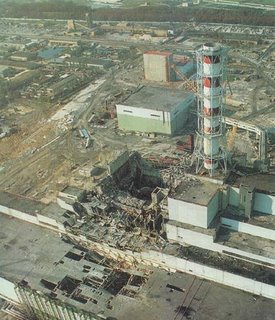The RBMK Reactor used at Chernobyl had a bad design flaw. It was highly unstable at low power output. The reactor used water as a moderator – a neutron absorber that slows down a nuclear reaction. When water boils, it creates steam which is a very poor moderator. When excess steam pockets formed in the RBMK reactor, it led to increased power generation (known as a positive void coefficient). This excess power caused additional heating thus producing more steam and less neutron absorption causing the problem to escalate. All of this happens very rapidly and if not stopped quickly is almost impossible to stop, as was evidenced on April 25, 1986.
As Reactor #4 was to be shutdown for routine maintenance, it was decided to take advantage of this shutdown to run a test. The test was to check whether, in the event of a shutdown enough electrical power was available to operate the emergency equipment and core cooling pumps until the diesel power supply came online. For the test the reactor was to be stabilised at 1,000MW prior to shutdown, however, due to operational error the power fell to about 30MW where the positive void coefficient became a problem. The operators tried to raise the power by freeing all the control rods manually and at 01:00hr on 26 April the reactor stabilised at 200MW. At this point they still had a chance to ABORT the test and avoid disaster. But it was not to be.
The sudden increase in temperature caused part of the fuel to rupture, fuel particles then reacted with the water creating a steam explosion which destroyed the reactor core. A second explosion added to the destruction two minutes later.
I work in the chemical industry and deal with risk on a daily basis. My generation has certainly learned from this tragedy and from Bhopal. And we apply the lessons learned on a daily basis. I hope this next generation will continue to do so and prevent another Chernobyl from ever occurring.
As for nuclear power in this country on the 20th anniversary of Chernobyl? Maybe someday the youngsters of today might realize this accident for what it was, and believe in a safe nuclear power plant again. It will certainly go a long way to alleviating our energy crisis. But I wouldn’t bet the farm on it.

